Peach:
Oriental Fruit Moth: A biofix point for OFM was set on 4/11 in southern counties, and on 4/14 in northern counties. The first generation timings are updated below.
| Insecticide Type | |||
| County/Region | Degree Days by 5/24 base 45 | Conventional
1150-1200 1450-1500 |
Diamide
1075-1150 1375-1450 |
| Gloucester – Southern | 595 | 1st –
2nd – |
1st –
2nd – |
| Middlesex – Northern | 526 | 1st –
2nd – |
1st –
2nd – |
Plum Curculio; Tarnished Plant Bugs; and Other Catfacing Insects: Plum Curculio start to move into orchards at about 88-100 degree days base 50 after January 1. Applications for PC should be initiated once all petals are off, with a second application made with ovicidal materials at 379-402 DD. Growers can monitor degree day development at their site by finding the nearest weather station and using the degree day development tool at NEWA. PC activity should be peaking this week and next. Catfacing insects are present at low levels in most orchards.
Scale Insects: White peach scale (WPS) crawlers are nearing peak emergence in southern counties. San Jose scale (SJS) crawlers usually begin emergence about a week or ten days later, usually late May/Early June. No SJS crawlers have been observed yet, but should begin anytime now. If you have scale infestations on your trees, it is important to note if crawlers are present, even if you treated with oil in the early spring. If crawlers are present then treatment options include Esteem, Movento, Centaur, Venerate, and Diazinon. Esteem, Centaur, Venerate and Movento should be applied at the beginning of crawler emergence. Movento requires a penetrant as per the label. Venerate should be be applied at the low rate of 1 qt/A and may need more than one application. Diazinon is labeled for only one post bloom or foliar application on stone fruit (Rec = max. of 2 lb/acre of the 50W). The apple label allows up to 2 foliar applications per year as long as a prebloom application was not made. Foliar applications may cause russet on apples, but has worked in the field for scale crawlers as long as applications are made 1-2 weeks after the start of crawler emergence and again 2 weeks later. Belay and Assail are also effective against scale crawlers but may need more than one application during the emergence which typically lasts about 4 weeks for WPS and 6 weeks for SJS.
Lesser Peach Tree Borer and Peach Tree Borer: Lesser Borer adults began flying this week in in all growing regions. If you haven’t placed mating disruption dispensers yet there is still time to get them out before the greater peach tree borer flight which usually begins in June.
Apples and Pears:
Diseases: Fire Blight, Apple Scab, Rust diseases, and Powdery Mildew are the main targets at this stage. The NEWA apple scab model is estimating about Primary Scab is over in southern NJ with 100% of cumulative ascospores discharged. Northern counties will have less ascospore maturity. Growers can estimate primary scab development using the NEWA scab tool, and estimate fire blight infection potential using the Fire Blight tool. Remember to enter your green tip and first blossom date! Primary apple scab spores are released during any substantial infection period. More information can be found in this blogpost from Penn State.
Codling Moth (CM): The first codling moth flight has started. A biofix was set for CM on April 25th in southern counties, and May 6 in Northern counties (Middlesex County). No biofix has yet been set for northern counties.
| Codling Moth Degree Day Timing | ||||||||
| Application and Insecticide Type | ||||||||
| County Area | Biofix | Rimon:
75-100DD + 14-17 days later
|
Intrepid
150 + 450 DD Diamides – Altacor, Voliam mixes: (150-200 DD) + 14-21 days later |
Cyd-X, Madex
250 DD + every 7-9 days during brood hatch (later if first spray is an IGR) |
Standard Insecticides – Delegate, Avaunt, OP’s, carbamates, pyrethroids
250 DD + 550 DD
|
|||
| DD | 75 | 100 | 150 | 450 | 250 | 250 | 550 | |
| Southern | April 25 | 5/7 | 5/12 | 5/15 | 6/2 | 5/21 | 5/21 | 6/7 |
| Northern | May 6 | 5/14 | 5/16 | 5/18 | 6/5 | 5/25 | 5/25 | 6/10 |
Tufted Apple Budmoth (TABM): Tufted Apple Budmoth (TABM): A biofix was set statewide on May 6. The first alternate middle applications for TABM will be on or about June 1 in all counties. This has been considered a minor pest in recent years. With the exception of Assail and and granulosis virus formulations (e.g. Madex), most materials used for Codling Moth will control TABM.
Rosy Apple Aphid: If a pre-bloom application was not made, monitor for colonies during bloom and use a treatment threshold of 1 colony/tree at petal fall. Some orchards have colonies that require treatment in southern counties.
Fire Blight: Shoot blight strikes were observed in several southern county orchards this week. Strikes should be removed during dry weather using the ugly stub method.
Grapes: Bloom is the critical time to protect against cluster infections from Downy and Powdery Mildew; Black rot; Botrytis; and ripe rot. Dr. Nita at Virginia Tech has a comprehensive summary of fungicide choices for bloom. Growers should also monitor wild grape bloom near thier vineyard and record the date the first wild grape bloom occurs. This is important for grape berry moth management using the NEWA Grape Berry Moth tool.
Tree Fruit Trap Counts – Southern Counties
| Weekending | STLM | TABM-A | CM | AM | OFM-A | DWB | OFM-P | TABM-P | LPTB | PTB |
| 4/9/2022 | 2 | 0 | 0 | |||||||
| 4/16/2022 | 0 | 2 | 3 | |||||||
| 4/23/2022 | 11 | 0 | 0 | 28 | 5 | 0 | 0 | |||
| 4/30/2022 | 5 | 0 | 1 | 31 | 4 | 0 | 0 | |||
| 5/7/2022 | 5 | 1 | 3 | 50 | 4 | 0 | 0 | |||
| 5/14/2022 | 8 | 5 | 3 | 19 | 2 | 0 | 0 | |||
| 5/21/2022 | 3 | 5 | 5 | 20 | 2 | 7 | 3 |
Tree Fruit Trap Counts – Northern Counties
| Weekending | STLM | TABM-A | CM | AM | OFM-A | DWB | OFM-P | TABM-P | LPTB | PTB |
| 4/9/2022 | ||||||||||
| 4/16/2022 | 0 | 0 | 1 | |||||||
| 4/23/2022 | 0 | 0 | 2 | 0 | ||||||
| 4/30/2022 | 0 | 0 | 2.5 | 0 | ||||||
| 5/7/2022 | 0 | 1 | 4 | 0 | ||||||
| 5/14/2022 | 1 | 2 | 0 | 4.5 | 0 | 0 | 0 | |||
| 5/21/2022 | 6 | 8 | 4 | 27 | 2 | 0 | 4.5 | 5.5 | 5 | 0 |
| Pest Event or Growth Stage | Approximate Date | 2022 Observed Date |
| Bud Swell (Redhaven) | March 23 +/- 15 Days | March 20 |
| 1/4″ Green Tip Red Delicious | March 31 +/- 13 Days | March 21 |
| Pink Peach (Redhaven) | April 4 +/- 15 Days | March 31 |
| Tight Cluster Red Delicious | April 9 +/- 13 Days | March 31 |
| Full Bloom Peach (Redhaven) | April 9 +/- 14 Days | April 10 |
| Pink Apple (Red Delicious) | April 14 +/- 12 Days | April 14 |
| Full Bloom Apple (Red Delicious) | April 22 +/- 11 Days | April 21 |
| Petal Fall (Redhaven) | April 22 +/- 10 Days | April 14 |
| Petal Fall (Red Delicious) | April 27 +/- 13 Days | May 3 |
| Shuck Split (Redhaven) | April 30 +/- 11 Days | April 26 |
| Pit Hardening | June 15 +/- 9 Days |
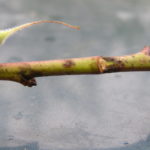
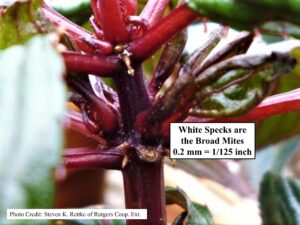
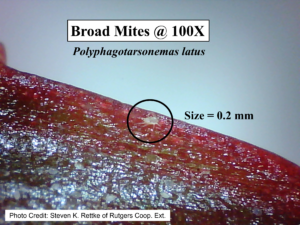
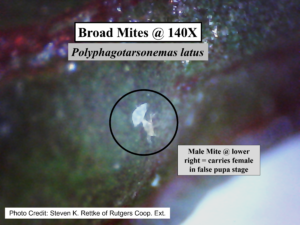
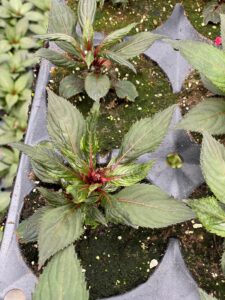
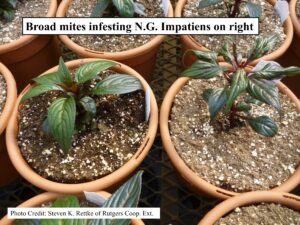 Dealing with Broad Mite, Greenhouse Product News
Dealing with Broad Mite, Greenhouse Product News